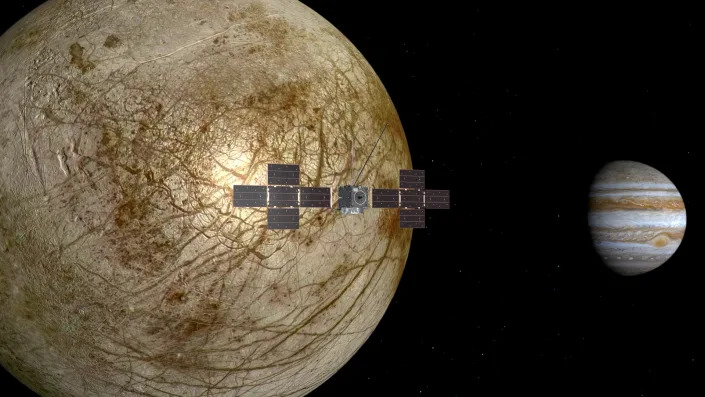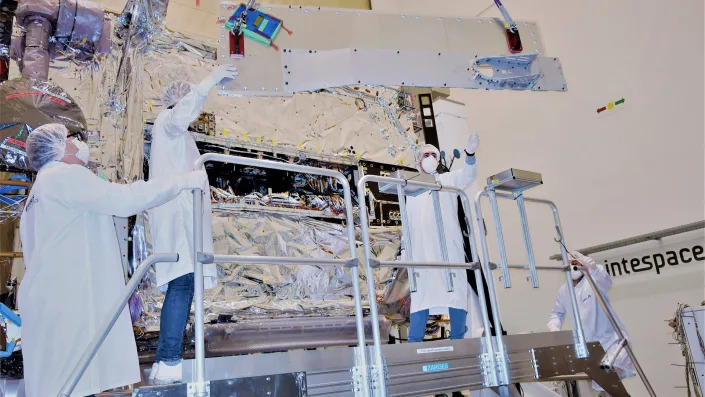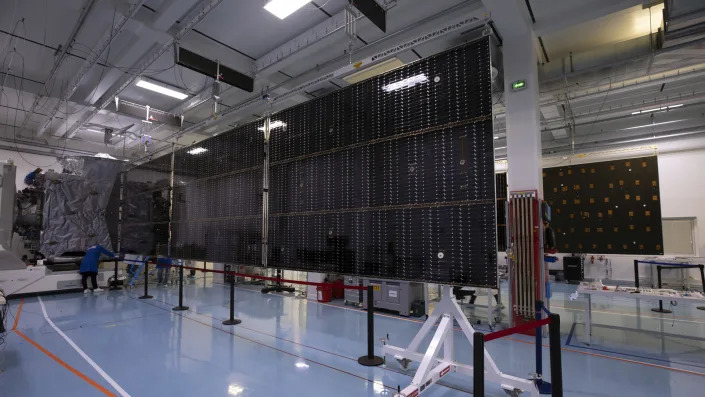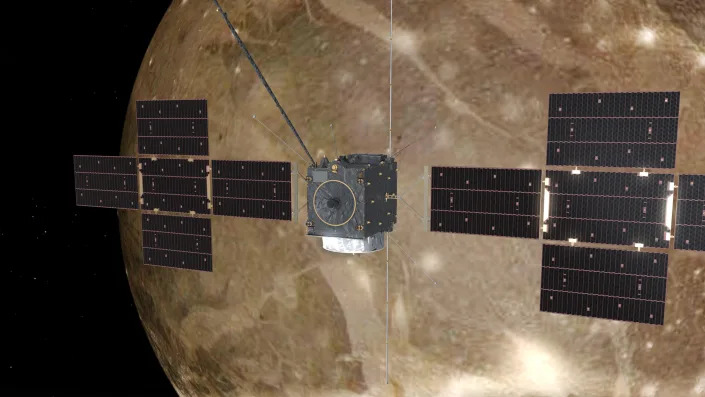ESA's Jupiter mission JUICE is not 'strong enough' to orbit potentially life-harboring Europa. Here's why
Tereza Pultarova
SPACE.COM
Sat, April 8, 2023

ESA's JUICE probe will take a look at Jupiter's moon Europa.
Europe's Jupiter Icy Moons Explorer (JUICE) spacecraft will set out on an ambitious explorative tour of Jupiter's moons next week. But the mission will only take the briefest glimpse of the potentially life-harboring moon Europa. Here's why.
Surviving on as little power as half a hair dryer and featuring a "nuclear bunker" to shelter its electronics from radiation, Europe's Jupiter Icy Moons Explorer (JUICE) is a technological marvel that wouldn't survive at Europa for long. The smallest of Jupiter's four main moons may be the likeliest place in the solar system to host extraterrestrial life in its ice-covered ocean; the environment around the moon, however, is so harsh, that it would kill a spacecraft in a couple of months at best, according to NASA.
Going to Jupiter is never easy. The closer you get to the gas giant and the longer you want to stay in its vicinity, the trickier it gets. Five times farther away from the sun than Earth, Jupiter lives in the solar system's twilight zone, receiving only about 4% of the sunlight that our planet gets. That means any visiting spacecraft wishing to rely on solar power has to have enormous solar arrays. The challenges only start here. Jupiter's magnetic field is 10,000 times stronger than that of Earth, which can have an effect on the spacecraft's scientific measurements, Justin Byrne, the head of Science Programs at Airbus Defence and Space, which led the consortium building the JUICE spacecraft, told Space.com. Worst of all, this super-potent magnetic field traps and supercharges particles that Jupiter and its volcanically hyper-active closest moon Io pump into space around the planet. As a result, radiation levels in the planet's proximity are as high as in the epicenter of a nuclear explosion.
Related: Behold! Our closest view of Jupiter's ocean moon Europa in 22 years
Sat, April 8, 2023

ESA's JUICE probe will take a look at Jupiter's moon Europa.
Europe's Jupiter Icy Moons Explorer (JUICE) spacecraft will set out on an ambitious explorative tour of Jupiter's moons next week. But the mission will only take the briefest glimpse of the potentially life-harboring moon Europa. Here's why.
Surviving on as little power as half a hair dryer and featuring a "nuclear bunker" to shelter its electronics from radiation, Europe's Jupiter Icy Moons Explorer (JUICE) is a technological marvel that wouldn't survive at Europa for long. The smallest of Jupiter's four main moons may be the likeliest place in the solar system to host extraterrestrial life in its ice-covered ocean; the environment around the moon, however, is so harsh, that it would kill a spacecraft in a couple of months at best, according to NASA.
Going to Jupiter is never easy. The closer you get to the gas giant and the longer you want to stay in its vicinity, the trickier it gets. Five times farther away from the sun than Earth, Jupiter lives in the solar system's twilight zone, receiving only about 4% of the sunlight that our planet gets. That means any visiting spacecraft wishing to rely on solar power has to have enormous solar arrays. The challenges only start here. Jupiter's magnetic field is 10,000 times stronger than that of Earth, which can have an effect on the spacecraft's scientific measurements, Justin Byrne, the head of Science Programs at Airbus Defence and Space, which led the consortium building the JUICE spacecraft, told Space.com. Worst of all, this super-potent magnetic field traps and supercharges particles that Jupiter and its volcanically hyper-active closest moon Io pump into space around the planet. As a result, radiation levels in the planet's proximity are as high as in the epicenter of a nuclear explosion.
Related: Behold! Our closest view of Jupiter's ocean moon Europa in 22 years
Satellite radiation sickness
Orbiting Jupiter at a distance of 417,000 miles (671,000 km), nearly double the moon-Earth distance, Europa is Jupiter's second closest moon. Radiation levels around Europa are not quite as high as around the closest Io, still, scientists know the radiation dose an object in orbit around Europa would receive within one day is, at 5.4 Sievert, more than two times the value that causes severe radiation sickness to humans. Of course, a spacecraft is not a human, but Byrne admits, such radiation levels are beyond what spacecraft designers are used to building for.
"We are used to radiation in space," Byrne said. "Missions orbiting Earth have to go through Earth's radiation belts, but the radiation levels there are nowhere near to what a spacecraft is exposed to near Jupiter."
High levels of radiation are bad news for electronics and solar panels. The more intense the radiation, the sooner electronic systems malfunction and the faster solar arrays degrade, said Byrne. For this reason, NASA's own Europa Clipper mission will not search for traces of life on Europa directly from the moon's orbit, but will instead make brief periodic visits while in a wider orbit around Jupiter. And for this reason, the European Space Agency (ESA) chose Jupiter's largest and somewhat cozier moon Ganymede, as JUICE's primary target.

Electronics of Europe's Jupiter explorer JUICE are encased in a lead-line vault that protects them from the severe radiation around the planet.
Cozy Ganymede
Although Ganymede is less likely to harbor life than Europa, according to scientists, the moon is far from boring. Larger than the solar system's smallest planet Mercury, Ganymede is the biggest moon in the entire solar system and the only one known to generate its own magnetic field. In 2034, three years after JUICE's arrival at Jupiter (if all goes to plan), Ganymede will become the first moon apart from Earth's own moon to have a spacecraft in its orbit.
Orbiting Jupiter at a distance of 665,000 miles (1,070,000 km), Ganymede is the third closest to the gas giant of the four main moons. Radiation around Ganymede is about 100 times weaker compared to Europa, said Byrne. Still, the JUICE spacecraft wouldn't survive in this environment for long without some never before used solutions.
At the heart of the 2.7-ton (2.42 metric tonnes) spacecraft is a lead-lined vault that houses all of the spacecraft electronics (except for the scientific instruments designed to study the extreme environment in the Jupiter system).
"There are kilograms of lead on JUICE," Byrne said. "And that effectively limits the amount of radiation that can get to the electronics and extends their life. But eventually, they will die. You can't stop it forever."
If the spacecraft were to go to Europa, this lead-lined nuclear mini-bunker would have to be much more robust, Byrne added.

The JUICE spacecraft during a solar array deployment test.
The death of solar panels
But while there is a solution to protect the electronic systems, the solar arrays are completely exposed to the radiation. Byrne thinks that the degradation of JUICE's solar panels in the harsh environment around Jupiter will lead to the mission's eventual demise.
Due to Jupiter's distance from the sun and the low intensity of sunlight around the planet, JUICE's solar panels have to be enormous. Designed as two cross-shaped wings, the arrays cover an area of 915 square feet (85 square meters). Despite this enormous size and record-breaking efficiency of about 30%, the arrays don't even produce enough electricity to power a hair dryer, said Byrne.
"It's already a very small amount of power and as they degrade over their lifetime because of the radiation, their performance will go down to a point at which there will not be enough power for the mission to operate," Byrne said.
JUICE is designed to survive four years combined orbiting first Jupiter and then Ganymede. Prior to entering Ganymede's orbit, the spacecraft will make two flybys at Europa, 21 at the most distant and least explored moon Callisto, and 12 at Ganymede. Byrne is confident that Airbus engineers and their collaborators from all over Europe built the spacecraft sturdy enough to get through its mission. It is unlikely, however, that JUICE will outlast its life expectancy, unlike many other missions.
"It might survive a little longer but it will not last for 10 years like many other missions do," said Byrne.
In addition to the extreme radiation environment, the mission will also consume a huge amount of fuel due to the large amount of fuel-consuming flybys of Jupiter's moons.
"There will be a lot of course corrections, trajectory changes," said Byrne. "That will require lots of fuel. So either the fuel will run out first, or the solar arrays will degrade, and that will cause us to terminate the mission."
Operators will want to end JUICE's mission in time by sending it to crash into Ganymede in order to prevent the spacecraft from turning into an out-of-control piece of space junk and potentially crashing into Europa later, contaminating it with earthly microbes. Since scientists don't think Ganymede is likely to host life and since its surface doesn't appear to be in touch with its subsurface ocean (unlike the surface of the more active Europa) experts are not worried about JUICE cluttering that moon's pristine ice crust.

ESA's Juice spacecraft orbiting Jupiter's moon Ganymede.
So what would it take to send JUICE into orbit around Europa?
Related stories:
— NASA flyby of Jupiter's big moon Ganymede reveals auroras and huge unknown craters
— Massive, months-long volcanic eruption roils Jupiter's moon Io
— New auroras detected on Jupiter's four largest moons
But with all those challenges, does it mean that it's impossible to have a spacecraft orbiting Europa, the likeliest place in the solar system to host extraterrestrial life?
Byrne says that engineers are currently studying those possibilities in the hope of sending a sterile lander to Europa in a more distant future.
"It's a challenge that is being looked at," said Byrne. "It would need much more protection for the electronics and probably much larger solar arrays. That means much more mass. But we can probably do it."
Such a mission would, according to ESA's JUICE launch kit, only take off years after JUICE and NASA's Clipper (set to launch next year) complete their missions. The two missions, which will succeed NASA's Juno spacecraft that's been studying Jupiter since 2016, are paving the way for our ultimate encounter with Europa's potential and likely microbial life.
Follow Tereza Pultarova on Twitter @TerezaPultarova.
No comments:
Post a Comment